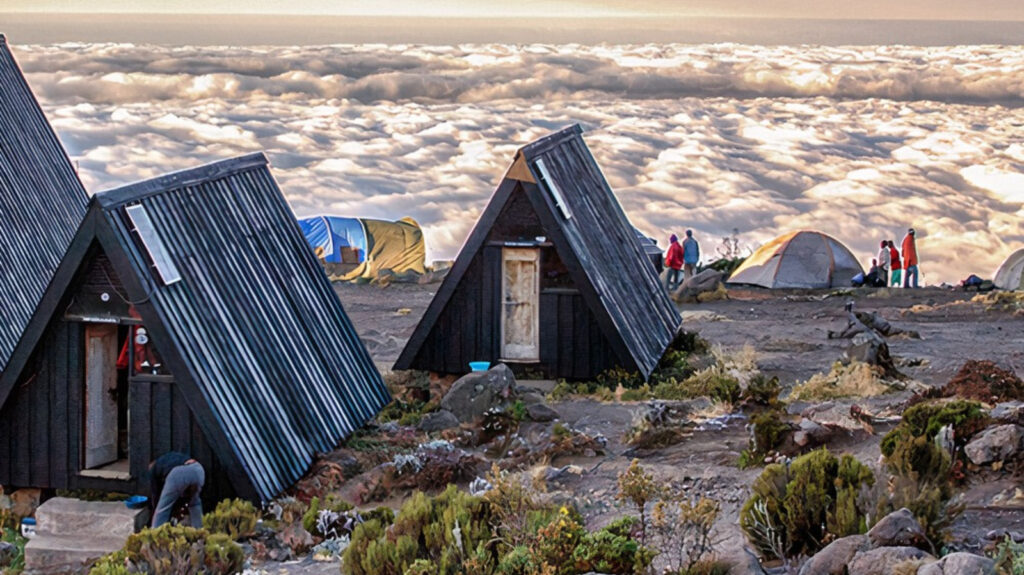Details
Overview
Marangu Route 6 Days – The Kilimanjaro trekking Marangu Route is perhaps the easiest and most comfortable route to reach the summit of Mt Kilimanjaro. The route is well-developed and the climb is constant and moderate. Only the approach to the summit is the exception as it is slightly more demanding. The accommodation on this tour is in simple mountain huts, which might be an advantage compared to the camping routes.
Depart Arusha/Moshi around 0800hrs to Marangu Gate for the Mountain Climb Registration. Begin your Kilimanjaro trek by walking along a narrow trail through the rainforest of Kilimanjaro for most of the hike. Eat a picnic lunch at Kisambioni, day one’s halfway point. After lunch continue walking through the rainforest until reaching Mandara Hut. Relax for the rest of the day or take a short walk to Mahundi Crater. The views to the east over Taveta and to the northwest to Mawenzi Peak are striking on a clear day, making the short hike well worth the effort.
After breakfast, depart Mandara Hut and Kilimanjaro forests to Horombo Hut. Most of the day’s hike will be through Kilimanjaro moorland, a rocky landscape with desert-like plants. Have your picnic lunch at Kambi ya Taabu before continuing to Horombo Hut. If the day is clear, enjoy beautiful views of Mawenzi and Kibo peaks. Arrive at Horombo Hut at around 1500hrs and spend the rest of the afternoon relaxing.
This extra day and night at Horombo are ideal for body acclimatization. A hike towards Mawenzi, passing through Zebra Rocks on the way (about 3 hours up and 1.5 hours down), is strongly recommended as it will further assist with acclimatization.
Hiking Time: 5-6 hours
Elevation Change: +3018ft/+920 m
Estimated Distance: 7.46 miles
Habitat: Alpine desert.
After breakfast continues your ascent into the Alpine desert, passes the last water point at 13550 ft/4130m. You will have to fill your water bottles with all the water you will need until your return to Horombo hut in two night’s time (unless you are willing to buy Mineral water at Kibo hut). The summit is now a further 3921ft /1195m up and you will make your final ascent the same night. Go to bed around 1830hrs and try to get as much rest and sleep as possible.
Around 2330hrs, you will wake up and after some tea and biscuits you shuffle off into the night, and this is where the going really gets tough. The first section of the trail consists of a rocky path to the Hans Meyer point (17225ft/5250m), also a good resting spot. The path then zigzags up to Gillman’s point (18639ft/5 681m), which is located on the crater rim. This section is very steep with a lot of stone screed, requiring a great physical and mental effort.
From Gillman’s Point, you will normally come across snow all the way up to Uhuru peak (19341ft/5895m), the highest point in Africa. Weather conditions on the summit will determine how long you will be able to spend, taking photographs before the 3 hours descent back to Kibo hut. After a short rest you gather all your gear you left behind for the ascent and head down to Horombo hut (3 hours) for your overnight. Later in the evening you enjoy your last dinner on the mountain and a well-earned sleep, filled with memories and stirring emotions.
After breakfast, end the trek with a descent to Marangu Gate. Your last trek on Kilimanjaro is a beautiful one, passing through Kilimanjaro’s cloud forest. Watch your step during the descent, as the trail can be slippery. At Marangu Gate, you will sign for departure. This is also where successful climbers receive their summit certificates. Those climbers who reached Gillman’s Point (18652ft/5685m) are issued with silver certificates and those who reached Uhuru Peak (1 9341ft/5895m), receive gold certificates. Our vehicles will be waiting at Marangu Gate to take you back to Arusha.Accommodation and food
The accommodation is in good huts. The lower huts have spacious dining rooms, where you will be served meals cooked by your cook. All food and utensils will be carried by the porters and cooked by an experienced cook. It will be plentiful and delicious. Beer and soft drinks are available at the huts.
Your own supply of chocolate and high-energy snacks is a good idea.Water is available at several points and should be purified before drinking. All water at the huts will be boiled and some provided for drinking the next day. A comforting tip is to fill your bottle in the evening with boiled water for the next day, and to use it as a hot water bottle overnight. There are water points between the huts – check with your guide.
Acclimatization is extremely important, both to let you enjoy your ascent but more importantly to avoid any serious complications. The route is planned to optimize the height gain, but you may still get a headache or feel nauseous. There are two important preventative measures: to drink copiously, even when it is really difficult, and to walk very slowly, avoiding as far as possible increased heart and breathing rates.
A drug, Diamox, is available from your GP and is well proven to help with acclimatization. This is taken as tablets for a few days before and then during your ascent. It is safe and has no serious side effects. It is important to remember that one possible effect of altitude is light-headedness and odd behavior, which can lead to foolish decisions. The danger here is of someone who is not well insisting on continuing
